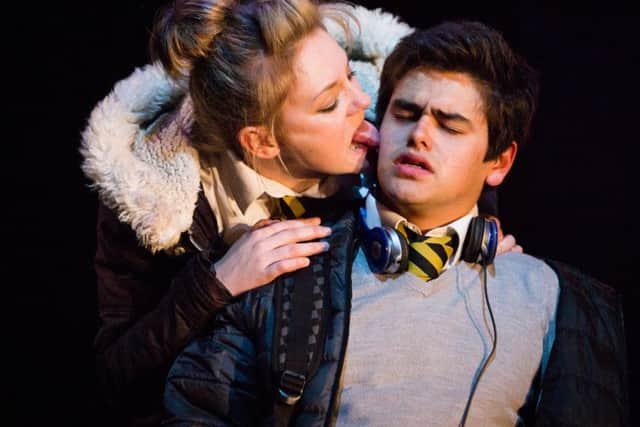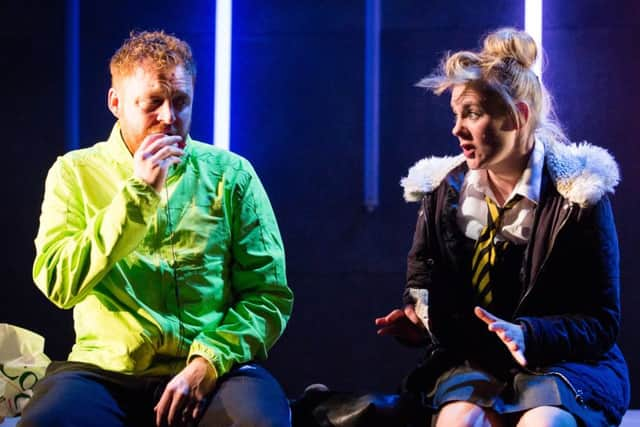How Traverse Theatre's headliner was picked from the submissions pile


The actor turned playwright, whose first full-length play Milk was picked up from a pile of unsolicited submissions to become the Traverse’s main-stage production for the Fringe is on the threshold of a great opportunity – but there’s a lot at stake.
“When I heard the play was going to be staged for the Festival, I don’t think I was fully aware of the enormity of what it meant,” says Dunsmore, who is Scottish but lives in London. “Over the past few months, I’ve slowly come to realise how extraordinary this is and how special it is to have my work on here in the midst of this celebration of art and culture.”
Advertisement
Hide AdAdvertisement
Hide AdTraverse artistic director Orla O’Loughlin, who directs Milk, says the discovery of the play is a validation of the theatre’s open submissions system (they promise that all manuscripts received during its submission season will be read anonymously).


“It’s time-consuming and costly, especially in this austerity-bitten sector, and this work is largely unseen, but I would argue that, as Scotland’s new writing theatre, it’s something we have to protect and celebrate. It symbolises what we’re here to do, which is to discover, support and then give powerful platforms to new writing talent.”
She remembers the morning when she arrived at work to find the script for Milk placed strategically on her desk. “Not long afterwards, our trainee director at the time Andy MacNamee popped his head round the door and said ‘I think you’ll like this’. And he was absolutely right, I read it and I thought: ‘We have to do this play’.
“Ross has a really vivid way with language, a real sense of rhythm and image. It felt theatrical, it has a heightened sensibility, it’s not televisual naturalism, as a director that feels exciting. It’s very clear that Ross is an actor, that control and understanding of language, punctuation, pause, rhythm. I could see the joy of it in performance.”
For a play to go straight from the slush pile to the main stage is unusual, but not unheard of. Crash, by Andy Duffy, performed at last year’s Fringe, was picked up as an unsolicited script, and went on to be nominated for several CATS Awards.


The most famous example is Gagarin Way, written by Gregory Burke when he was working as a dishwasher, which became an overnight sensation and a hit all over the world. However, for every manuscript that is staged, there are 100 which are not.
When Dunsmore found himself invited to the Traverse for “a chat” he still had no idea that O’Loughlin intended to stage the work. “At that point my expectation was it would be nice to form a connection with the Traverse, they might come and see some future work. Then after developing the play for about a year, Orla said they’d like to do it at the Festival, and I said, ‘Okay, yeah, fair enough’.” He grins. “I wasn’t fully embracing what that meant!”
Advertisement
Hide AdAdvertisement
Hide AdDunsmore, who has worked widely across theatre, film and television as an actor, became interested in playwrighting after feeling “artistically frustrated”.


“I was in a bad accident and nearly died, and that woke me up to the idea that I wanted to pursue projects that were artistically interesting. When you have a blank sheet of paper and a pen, there is a great amount of freedom and a great amount of authority over your own vision.”
He studied film and playwrighting, and gradually came to realise he felt most comfortable writing for the stage. “I don’t feel limited by it. There is a naturalism in writing for television, but there is a freedom that anything is possible. You can be very brave as a theatre writer, and that bravery is encouraged, you can go and find big bold ideas and pursue them.”
Milk is the story of three couples: Steph (Helen Mallon) and Ash (Cristian Ortega), teenagers finding their way into a relationship: Danny (Ryan Fletcher) and Nicole (Melody Grove) in their early 30s, having their first child; May (Ann Louise Ross) and Cyril (Tam Dean Burn) living out their old-age in the prefab where they’ve stayed most of their lives, shuttering the windows against the rest of the world.
Dunsmore says the idea for Milk began to form when he overheard a group of teenagers talking on a bus. “They’d been at a party the night before and were relating various things that had happened, and one girl said, ‘Did you hear that Tony ripped off Stacey’s top?’ And I expected the answer to be something like, ‘That’s terrible!’ But the girl next to her just said ‘Yeah, he really likes her’.


“It stuck in my mind as a strange articulation of affection. I wondered what the person who did the ripping needed, and what the person being ripped at needed, and I started to become interested in the idea of nourishment and sustenance.”
This connected to another thought, a prefab near his home where the windows are boarded up from the inside, but the garden is immaculate. “It would appear that somebody still lives there and comes out, maybe in the early hours or late at night, and tends this garden. And I started to think: who is that person? Are they too scared to come out into the world? And what do they need?
Advertisement
Hide AdAdvertisement
Hide Ad“Also, when our first child was born, the feeding was very tricky and time that has stayed with me. Those three ideas seem to gather round a theme of nourishment, sustenance, what we need, what we think we need, how we negotiate these difficulties if it’s not working for us.”
The team making Milk is the same which made last year’s Fringe-First winning Swallow, by Stef Smith: O’Loughlin directing, designer Fred Meller, Danny Kass as composer and sound designer and Philip Gladwell on lighting design.
In the rehearsal room, they have mapped out the shape of the stage in Traverse One to show how the three stories will interweave, even as the characters’ lives interweave towards fragile points of connection.
O’Loughlin said she set out to cast “an ensemble, a set of six”. “When you’re casting a couple, you can never cast in isolation.” I watch as the six actors gradually morph into character, Burn and Ross into two people in advanced old age, Ortega and Mallow into school-bag carrying teenagers. Grove disappears briefly behind a screen and comes back heavily pregnant.
And the teenagers? They wouldn’t stop talking. “A lot of writing is listening. The teenagers get written really quickly because you hear them, on a bus, in McDonald’s, wherever. There’s this energy, this rhythm that’s relentless and sparky, over time you absorb it. Sometimes it was hard stopping them, I’d have to say: ‘This is the end of the scene now, you have to stop and give other people a chance!’”
Milk, Traverse Theatre, until 28 August, various times. Tomorrow, 7pm.
